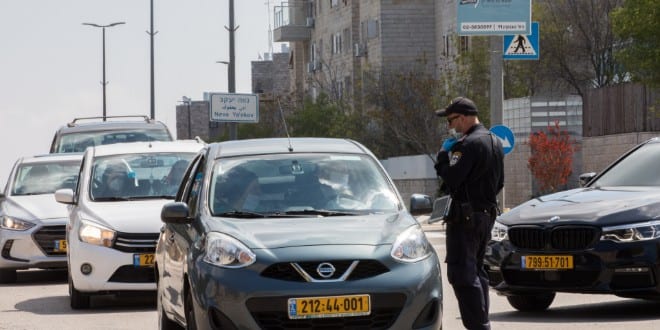(April 12, 2020 / Israel Hayom) Several Jerusalem neighborhoods went into full lockdown on Sunday afternoon following a late-night Security Cabinet meeting. The lockdown primarily focuses on ultra-Orthodox neighborhoods with high COVID-19 morbidity rates, and will remain in effect until April 15.
The lockdown move comes after days of deliberation, and despite protests by Jerusalem Mayor Moshe Lion. Some ministers who had received the proposal and the accompanying map were reportedly furious over the idea. At least two Cabinet members, Interior Minister Aryeh Deri and Health Minister Yaakov Litzman, live in areas that will be locked down. Litzman is currently under home-quarantine after testing positive for the virus last week.
According to Israeli Health Ministry data, about 75 percent of the coronavirus infections in Jerusalem have occurred in ultra-Orthodox neighborhoods, most of which will now be locked down. As of Sunday, the number of confirmed coronavirus cases nationwide stood at 10,878, with 103 fatalities. Over 1,300 have recovered from the disease, according to the latest ministry figures.
Israeli Prime Minister Benjamin Netanyahu and Deri engaged in a heated argument Thursday night during which Deri said he felt that the ministry was “quick on the trigger” when it came to imposing restrictions on ultra-Orthodox communities.
Nevertheless, the government approved the quarantine of four of the capital’s seven zones, as delineated ahead of Passover: Zone 1, which covers northeast Jerusalem; Zone 2, which covers northwest Jerusalem; Zone 3, which covers southwest Jerusalem; and Zone 5, which covers much of the city center.
Among the neighborhoods placed under lockdown are Har Nof, Mea Shearim, Geula, the Bukharim Quarter, Romema, Sanhedria, Neveh Yaakov, Ramat Shlomo and Makor Baruch.
Residents of these areas cannot leave them unless they are going to work, getting essential medical treatment, attending the funeral of an immediate family member or transferring their children to a former spouse. In addition, they can attend legal proceedings or access other essential services, with approval.
In each zone, several neighborhoods were excluded from the quarantine.
• Zone 1 exceptions: The Atarot industrial zone, Kafr Akab, Beit Hanina, Pisgat Ze’ev and the Hashalom neighborhood.
• Zone 2 exceptions: Har Hotzvim industrial zone, Arazim Valley Park and Motza Valley Park.
• Zone 3 exceptions: Givat Shaul industrial zone, Beit Hakerem, the Har Herzl administrative area, Yuvalim, Ir Ganim, Kiryat Denia and Hadassah Ein Kerem hospital
• Zone 5 exceptions: The Government Quarter administrative area and Beit David, which includes the Old City.
According to ministry data released last week, Har Nof had 118 infections out of a population of some 17,000, making it the area with the highest infection rate in the country. Another 416 cases were confirmed in “northern Jerusalem haredi [ultra-Orthodox] neighborhoods” out of a population of below 80,000.
There were over 1,800 total cases in the city and at least 21 residents have died of the disease, according to ministry data released Saturday.
This article first appeared in Israel Hayom.



